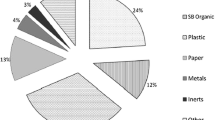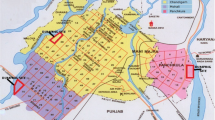Abstract
The organic fraction of urban wastes can be considered a cost effective source of added value products for a wide number of uses. The present chapter describes different possible strategies for the treatment of organic wastes, used at the present time in many waste treatment plants. Subsequently the chapter deals with the isolation process of soluble bio-based substances (SBO) from urban biowastes at both laboratory and pilot plant scale. A detailed description of SBO composition and physical-chemical characterization is given.
Access this chapter
Tax calculation will be finalised at checkout
Purchases are for personal use only
Similar content being viewed by others
References
UNESCAP Green Growth Path. (2014). www.greengrowth.org. Last access June, 2014.
European directives: 91/156/CEE, 91/689/CEE, 94/62/CE.
Kaminsky, J. (2004). Development of strategies for deployment of biomass resources in the production of biomass power. NREL/SR-510-33524, available electronically at http://www.nrel.gov/docs/fy04osti/33524.pdf.
Montoneri, E., Savarino, P., Bottigliengo, S., Boffa, V., Bianco Prevot, A., Fabbri, D., & Pramauro, E. (2009). Biomass wastes as renewable source of energy and chemicals for the industry with friendly environmental impact. Fresenius Environmental Bulletin, 18, 219–223.
Fantozzi, F., & Buratti, C. (2009). Biogas production from different substrates in an experimental continuously stirred tank reactor anaerobic digester. Bioresource Technology, 100, 5783–5789.
Tambone, F., Genevini, P., D’Imporzano, G., & Adani, F. (2009). Assessing amendment properties of digestate by studying the organic matter composition and the degree of biological stability during the anaerobic digestion of the organic fraction of MSW. Bioresource Technology, 100, 3140–3142.
www.clarke-energy.com/gas-type/biogas/. Last access July 2014.
Kraft, E., Bidlingmaier, W., De Bertoldi, M., Diaz, L. F., & Barth, J. (2006). Biological waste management from local to global. In Proceedings of the International Conference ORBIT 2006, Weimar (pp. 1201–1210), ISBN 3-935974-09-4.
Mabee, W. E., Gregg, D. J., Arato, C., Berlin, A., Bura, R., Gilkes, N., et al. (2006). Updates on softwood-to-ethanol process development. Applied Biochemistry and Biotechnology, 129, 55–70.
Lusk, P. (1998). Methane recovery from animal manures. The current opportunities casebook. NREL/SR-580-25145, available electronically at http://www.nrel.gov/docs/fy99osti/25145.pdf.
Montoneri, E., Mainero, D., Boffa, V., Perrone, D. G., & Montoneri, C. (2011). Biochemenergy: a project to turn an urban wastes treatment plant into biorefinery for the production of energy, chemicals and consumer’s products with friendly environmental impact. International Journal of Global Environmental Issues, 11, 170–196.
EPA/625/R-92/013, available electronically at www2.epa.gov/sites/production/files/documents/625R92013ALL.EPA/625/R-92/013.
Rathi, S. (2007). Optimization model for integrated municipal solid waste management in Mumbai, India. Environment and Development Economics, 12, 105–121. doi:10.1017/S1355770X0600341X, available at www.environmental-expert.com/Files%5C5253%5Carticles%5C14338%5Cart6.pdf.
Bech, R. W. (2004). Anaerobic Digestion Feasibility Study, Final report for the Bluestem Solid Waste Agency and Iowa Department of Natural Resources, available at www.iowadnr.gov/waste/policy/files/bluestem.pdf.
Vargas, A. K. N., Bianco Prevot, A., Montoneri, E., Le Roux, G. C., Savarino, P., Cavalli, R., et al. (2014). Use of biowaste-derived biosurfactants in production of emulsions for industrial use. Industrial and Engineering Chemistry Research, 53, 8621–8629.
Montoneri, E., Tomasso, L., Colajanni, N., Zelano, I., Alberi, F., Cossa, G., & Barberis, R. (2014). Urban wastes to remediate industrial sites: A case of polycyclic aromatic hydrocarbons contamination and a new process. International Journal of Environmental Science and Technology, 11, 251–262.
Baxter, M. D., Acosta, E., Montoneri, E., & Tabasso, S. (2014). Waste biomass-extracted surfactants for heavy oil removal. Industrial and Engineering Chemistry Research, 53, 3612–3621.
Boffa, V., Perrone, D. G., Magnacca, G., & Montoneri, E. (2014). Role of a waste-derived biosurfactant in the sol-gel synthesis of nanocrystalline titanium dioxide. Ceramic International, 40, 12161–12169.
Magnacca, G., Laurenti, E., Vigna, E., Franzoso, F., Tomasso, L., Montoneri, E., & Boffa, V. (2012). Refuse derived bio-organics and immobilized soybean peroxidase for green chemical technology. Process Biochemistry, 47, 2025–2031.
Franzoso, F., Tabasso, S., Antonioli, D., Montoneri, E., Persico, P., Laus, M., Mendichi, R., & Negre, M. (2014). Films made from poly (vinyl alcohol-co-ethylene) and soluble biopolymers isolated from municipal biowaste. Journal of Applied Polymer Science. doi:10.1002/app.41359.
Sortino, O., Montoneri, E., Patanè, C., Rosato, R., Tabasso, S., & Ginepro, M. (2014). Benefits for agriculture and the environment from urban waste. Science of the Total Environment, 487C, 443–451.
Baglieri, A., Cadili, V., Mozzetti Monterumici, C., Gennari, M., Tabasso, S., Montoneri, E., et al. (2014). Fertilization of bean plants with tomato plants hydrolysates. Effect on biomass production, chlorophyll content and N assimilation. Scientia Horticulturae, 176, 194–199.
Montoneri, C., Montoneri, E., Tomasso, L., & Piva, A. (2013). Compost derived substances decrease feed protein N mineralization in swine cecal fermentation. Journal of Agricultural Science, 13, 31–44.
Dinuccio, E., Biagini, D., Rosato, R., Balsari, P., Lazzaroni, C., & Montoneri, E. (2013). Use of acid soluble bio-organic substances extract as rabbits feed additive to reduce manure gases emission during storage. Advances in Animal Biosciences, 4(Special Issue 2), 515–520.
Montoneri, E., & Montoneri, C. (2012). Biopolymers isolated from residual biomass and fossil source; production processes and product uses. International Patent Application by the University of Torino, 21.12.2012, NO. PCT/IT2012/000399.
Montoneri, E. (2013). Plastic materials containing products isolated from residual biomass and fossils, and their sulfonated derivatives. International patent application by Acea Pinerolese, 06.12.2013, NO. PCT/IT2013/000339.
Avetta, P., Bella, F., Bianco Prevot, A., Laurenti, E., Montoneri, E., Arques, A., & Carlos, L. (2013). Waste Cleaning Waste: photodegradation of monochlorophenols in the presence of waste-derived photosensitizer. ACS Sustainable Chem Eng, 1, 1545–1550.
Gomis, J., Carlos, L., Bianco Prevot, A., Teixeira, A. C. S. C., Mora, M., Amat, A. M., Vicente, R., & Arques, A. (2014). Bio-based substances from urban waste as auxiliaries for solar photo-Fenton treatment under mild conditions: Optimization of operational variables. Catal Today, available online http://dx.doi.org/10.1016/j.cattod.2014.03.034.
De Stefano, C., Mineo, P., Rigano, C., & Sammartano, S. (1993). Ionic-strength dependence of formation-constants. The calculation of equilibrium concentrations and formation-constants. Annales de Chimie, 83, 243–277.
Santos, E. B. H., Esteves, V. I., Rodrigues, J. P. C., & Duarte, A. C. (1999). Humic substances’ proton-binding equilibria: Assessment of errors and limitations of potentiometric data. Analytica Chimica Acta, 392, 333–341.
Author information
Authors and Affiliations
Corresponding author
Editor information
Editors and Affiliations
Rights and permissions
Copyright information
© 2015 The Author(s)
About this chapter
Cite this chapter
Bianco Prevot, A. et al. (2015). Soluble Bio-based Substances Obtained from Urban Wastes: Isolation and Characterization. In: Arques, A., Bianco Prevot, A. (eds) Soluble Bio-based Substances Isolated From Urban Wastes. SpringerBriefs in Molecular Science(). Springer, Cham. https://doi.org/10.1007/978-3-319-14744-4_1
Download citation
DOI: https://doi.org/10.1007/978-3-319-14744-4_1
Published:
Publisher Name: Springer, Cham
Print ISBN: 978-3-319-14743-7
Online ISBN: 978-3-319-14744-4
eBook Packages: Chemistry and Materials ScienceChemistry and Material Science (R0)




